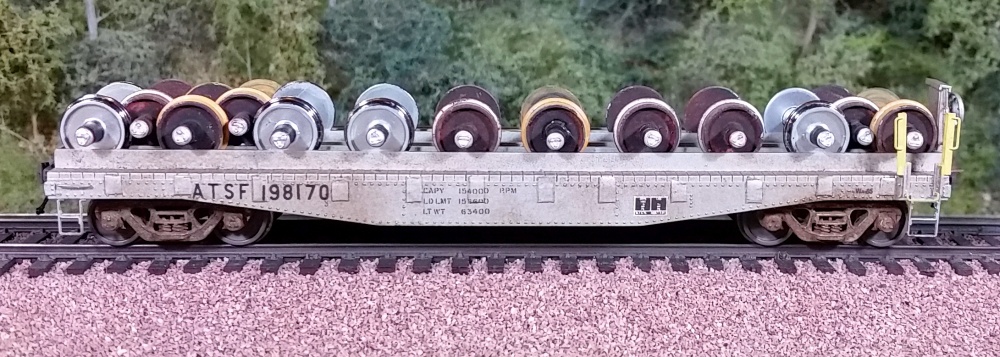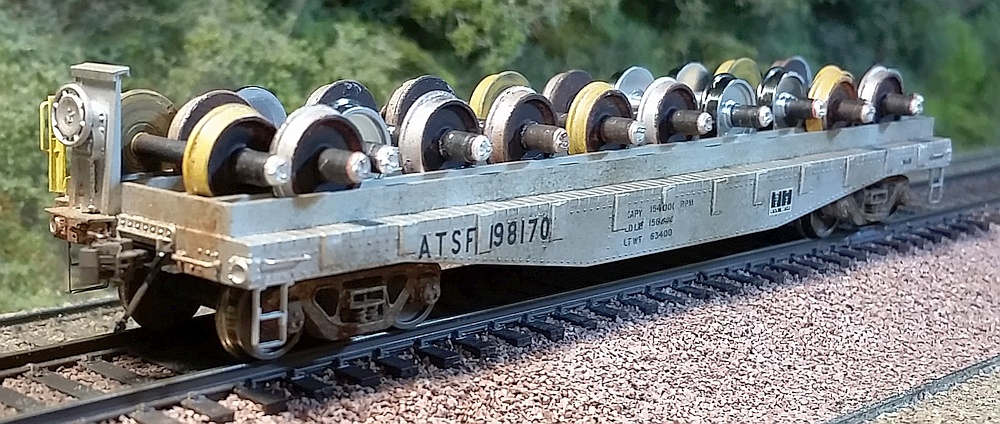|
|









ATSF MoW Wheel Car 198170
This car was inspired by photos of similar cars found on the internet. They are
used by railroads to move wheel sets for repairing damaged or worn freight cars.
This car was inspired by photos of similar cars found on the internet. They are
used by railroads to move wheel sets for repairing damaged or worn freight cars.
Below: Starting from a stock 40' flat car, I replaced the stirrups and grabs and added the yellow vertical safety grabs made from styrene
angle stock. The brake wheel assembly is scratch-built from bits of styrene. The wheel rack is also styrene strip. Based on prototype photos,
I added rough chunks of styrene along the car side to simulate the steel plates left over from whatever previous function the car served.
angle stock. The brake wheel assembly is scratch-built from bits of styrene. The wheel rack is also styrene strip. Based on prototype photos,
I added rough chunks of styrene along the car side to simulate the steel plates left over from whatever previous function the car served.
The freight car wheel sets were quite a lot of work - each one consists of 5 parts! The nickel-silver wheels/axles are one
part, and I glued on small styrene tubes (painted black) over each axle point. Then I glued on Details West BC-244 axle
bearing caps (painted silver). It's hard to see in the photos but each cap has a very thin hand-painted orange band
separating the silver and black. Some wheel faces and axles were brush-painted a grungy black, while others were left
shiny. A few wheel treads were dry-brushed light orange simulating fresh rust, a common occurance on freight car wheels.
part, and I glued on small styrene tubes (painted black) over each axle point. Then I glued on Details West BC-244 axle
bearing caps (painted silver). It's hard to see in the photos but each cap has a very thin hand-painted orange band
separating the silver and black. Some wheel faces and axles were brush-painted a grungy black, while others were left
shiny. A few wheel treads were dry-brushed light orange simulating fresh rust, a common occurance on freight car wheels.
Right: A prototype Santa Fe
wheel car with a single row of
wheels on board. This one is
painted aluminum as were most
Santa Fe maintenance cars.
Note the variety of wheel sizes
and colors.
wheel car with a single row of
wheels on board. This one is
painted aluminum as were most
Santa Fe maintenance cars.
Note the variety of wheel sizes
and colors.
Right: Another Santa Fe car,
this one painted mineral brown.
Note the second row of wheels
nested into the bottom level,
and a partial top row stacked on
and chained to the bottom row.
Also note the modified stirrup
step, yellow vertical grabs, and
brake stand at the right end.
this one painted mineral brown.
Note the second row of wheels
nested into the bottom level,
and a partial top row stacked on
and chained to the bottom row.
Also note the modified stirrup
step, yellow vertical grabs, and
brake stand at the right end.
The wheel rack is made from rectangular-profile styrene strips. Three longitudinal strips on each side form two
"bays" for two rows of wheels arranged side-by-side to set down into. A single crosswise strip forms each end of
the rack. Smaller pieces glued into the bays act as wheel stops and spacers allowing the two rows to nest properly.
"bays" for two rows of wheels arranged side-by-side to set down into. A single crosswise strip forms each end of
the rack. Smaller pieces glued into the bays act as wheel stops and spacers allowing the two rows to nest properly.








